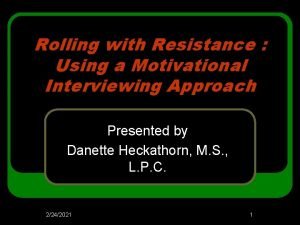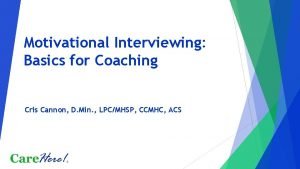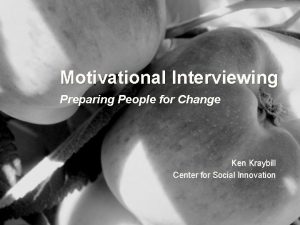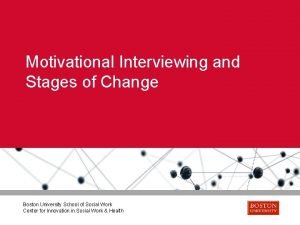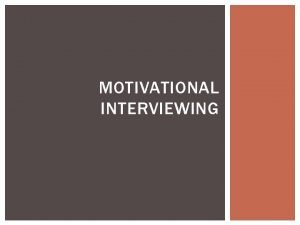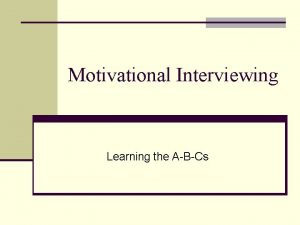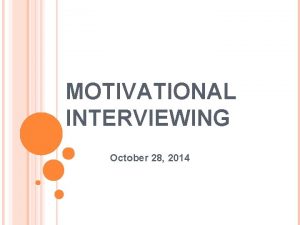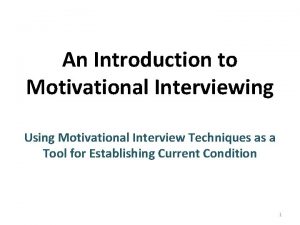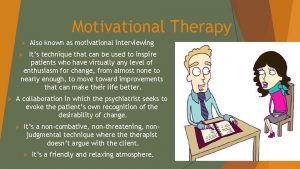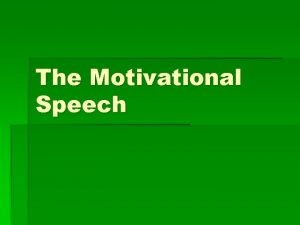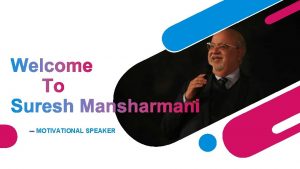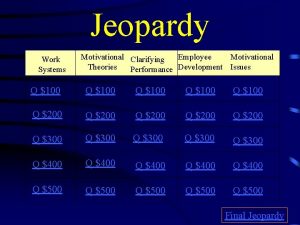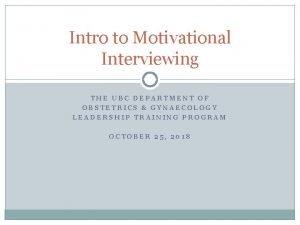MOTIVATIONAL INTERVIEWING In School What Is Motivational Interviewing

















- Slides: 17

‘MOTIVATIONAL INTERVIEWING’ In School

What Is Motivational Interviewing (MI)? • MI is a client centered, semi-directive method of engaging individuals in treatment or behavioral change. • MI aims to promote and increase motivation to change behaviors by exploring and resolving any issues of ambivalence the client may be experiencing. • MI addresses the client at their current state of functioning while addressing the varying levels of readiness for client change. • MI is non-judgmental, non-confrontational and non-adversarial.

MI in School Motivational interviewing, which began as a counseling technique in addiction recovery, is a client-centered tool for making changes, increasing helpful behaviors and decreasing unhelpful behaviors.

MI in School 1. It relies on an individual’s intrinsic motivation and interest in change, using a non-confrontational approach to frame goals in a practical, attainable fashion. 2 Teacherswho use motivational interviewing enhance their listening and problemsolving skills to become more effective communicators and as a result create better rapport with students.

Essence of MI The essence of motivational interviewing is captured by the two acronyms: OARS (open-ended questions, affirmations, reflective listening, summary statements) and FRAMES (feedback, responsibility, advice, menu, empathy, self-efficacy).

Open-ended Questions For example: “Tell me more about ___. ” “What happened next? ”

Affirmations For example: “You did very well on the last exam. ” “I noticed that you arrived to class on time, I appreciate that. ”

Reflective Listening For example: “It sounds like you want to create new study habits, but you don’t know where to start. ” “If I am hearing you correctly, you prepared for the exam by reading the chapter notes, but that was not enough. ” “Earlier you said that you were completely prepared for the exam, but it sounds like there might have been some additional steps you might have taken. ”

Summary Statements An example: “So, today we discussed some possible solutions to get you to class on-time, and learned that you want to take action to help solve the problem. ”

FRAMES Using the FRAMES (feedback, responsibility, advice, menu, empathy, self-efficacy) construction, teachers, advisors and others can help students take action and move forward. One of the tenets of motivational interviewing is to engage with positive momentum. Stay focused on moving forward to prevent getting stuck on issues in the past

Feedback must be delivered in a clear, nonjudgmental way that articulates discrepancies in the current behavior and the goal or new behavior. Responsibility links the problematic behavior with the action of the individual. It can be a clear reminder that the behavior is “owned” by the student. Advice can be used to provide alternatives to the undesirable behavior, to help negotiate challenging situations, or to build paths around an obstacles. But, it is up to the individual to consider the advice and decide whether or not to take action. Your role is to simply provide a new perspective or an option to consider.

Menus offer more than one solution to a problem and allow the individual to choose the path that will potentially be the most effective and helpful for the current challenge. Empathy allows you to build rapport by acknowledging that change can take effort and work, although this is not the case for all individuals, so it must be used with caution and sincerity. Self-efficacy increases the likelihood that the individual will feel empowered and capable of making a change and following through with a new behavior long-term.





THANK YOU FOR YOUR ATTENTION
 What is rolling with resistance
What is rolling with resistance Contoh motivational interviewing
Contoh motivational interviewing Dears motivational interviewing
Dears motivational interviewing Motivational interviewing schizophrenia
Motivational interviewing schizophrenia Cris cannon
Cris cannon Dears motivational interviewing
Dears motivational interviewing Ears motivational interviewing
Ears motivational interviewing Nimi singh
Nimi singh German motivational speech
German motivational speech Motivational interviewing
Motivational interviewing Ken kraybill
Ken kraybill Double sided reflection example
Double sided reflection example Readiness ruler motivational interviewing
Readiness ruler motivational interviewing Motivational interviewing
Motivational interviewing Change talk worksheet
Change talk worksheet Dares motivational interviewing
Dares motivational interviewing Active listening motivational interviewing
Active listening motivational interviewing Darn cat motivational interviewing
Darn cat motivational interviewing
